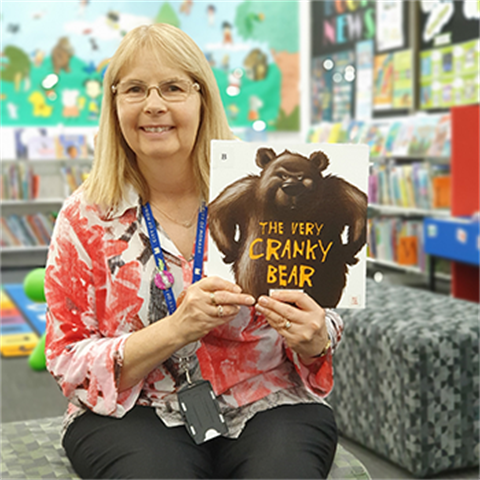SUZI: Rhyming Stories

Most children love rhymes. The rhythm, the playfulness, the sounds and often the humour, all lend themselves to an engaging reading experience.
Suzi, who until recently changing her role in our library service worked as Youth Librarian for an impressively long time, also loves rhymes. Yes, often the love of rhyming stories stays with us into adulthood! Suzi loves to read rhyming stories at Storytime and says children respond well to the musical beat, and that the rhyming helps them to memorise or anticipate words which can help them to join in.
“Rhyming introduces children to the beauty and music of language,” explains Suzi. “It’s their first introduction to poetry.”
Suzi values rhymes and rhyming stories because they are a rich source of language.
“Writers tend to use more words to make rhymes work, which means more words are introduced to children’s vocabularies.”
Suzi also notes that rhyming stories often withstand the test of time. There are many that are enjoyed across generations.
The language used in children’s stories has generally changed over time. Stories today often use language that is less dense, or simpler, than in past decades. Rhyming stories, especially those that have withstood the test of time, can help to compensate for this for those who benefit from richer language.
“Rhyming stories are also fantastic for children from non-English speaking families to build their English vocabulary. They can also help adults to learn English,” explains Suzi.
“A strong vocabulary helps children to express themselves in more nuanced ways.”
Phonological and phonemic awareness, the skills of both breaking down language into smaller parts as well as making the smaller sounds in spoken words, are important early literacy skills. Rhyming helps to highlight the sounds within words at a time children are most receptive to learning language. Later when they start school, they are better positioned to learn to read and spell.
Importantly, reading should always be fun for young children.
“Even if parents are focussed on their child developing their speech, it’s important for parents to use rhyming books for fun as well because it promotes a love of reading,” explains Suzi. “If children love to read from an early age, they are more likely to actively engage in more formal education when the time comes.”
While Suzi has extensive professional experience as a librarian specialising in children’s literature, she also draws on her own life experience.
“Mum used to recite poetry on long drives,” she recalls warmly. “The Man From Snowy River, we all memorised it, and it created bonding memories. We got the benefits of language while having fun as a family.”
Suzi has a number of favourite rhyming stories that she encourages families with young children to enjoy.
Boo! By Margaret Wild is an absolute favourite among children in their early years, and Suzi can see why when she shares the unfailing rhythm, bold clear pictures, and combination of wild animals with everyday life.
“Children will easily memorise the words and be able to join in with the storytelling. It’s fun, but also helps to create neural pathways in developing brains.” Suzi explains.
Edward the Emu by Sheena Knowles is another title that Suzi recommends. Originally published in 1988, it’s a great example of a picture book that has stood the test of time.
Children are fascinated and enthralled by zoos, and as Edward the emu addresses his boredom by exploring the lives and identities of the other animals, there is much fun to be had for the reader as well. This very fun rhyming story takes the reader to a happy ending, reminding us that being true to ourselves has value, as do our friends.
Another author whose books persistently age well are Lynley Dodd’s Hairy Maclary stories. Suzi highlights Hairy Maclary and Slinki Malinki in particular, but there are numerous others that feature Hairy Maclary and his friends, and his nemesis!
”Hairy Maclary is a lovable and free spirited dog,” Suzi describes. “He encapsulates the message of each story that encourages adventure, bravery and fun.”
“The stories use repetition in the rhyming to create a strong, memorable storyline that kids will remember. It builds an important pre-literacy skill.”
Piranhas Don't Eat Bananas by Aaron Blabey and The Very Cranky Bear by Nick Bland are two more recently published rhyming picture books that are immensely popular with children, and for good reason.
The Very Cranky Bear not only uses rhyme to maximise the phonemic benefits of the story, but goes further to help young children explore their own crankiness in an age-appropriate way.
“This book provides great talking points for children, but importantly it’s just really, really fun.” Suzi explains.
“We should never force children to read things they don’t enjoy because they’ll be less likely to develop literacy skills to their full potential. Books like The Very Cranky Bear are easy to enjoy, no matter who you are.”
Piranhas Don’t Eat Bananas uses very simple language and rhyming, but this allows the exploration of some important social-emotional concepts from a very young age.
“For parents with children who are picky eaters, this book is a must!” laughs Suzi.
“It might just encourage a stubborn eater to try something new on their plate, and it might just be a vegetable!”
Rhymes and repetition are good for young brains, and while reading generally helps to build neural pathways and early literacy skills, rhyming stories offer some extra benefits.
“Nursery rhymes are bite-sized opportunities to enjoy all the benefits of rhyme, with music as well.” Suzi notes. “They go hand-in-hand and encourage children to become interested in the patterns and sounds in language.”
All our Youth Librarians at Monash Public Library Service can recommend rhyming stories to you that are age-appropriate and address other needs or interests your child has. You can speak to a Youth Librarian at any of our branches, or search the library catalogue for Suzi’s recommendations and other titles.
View all recommended books